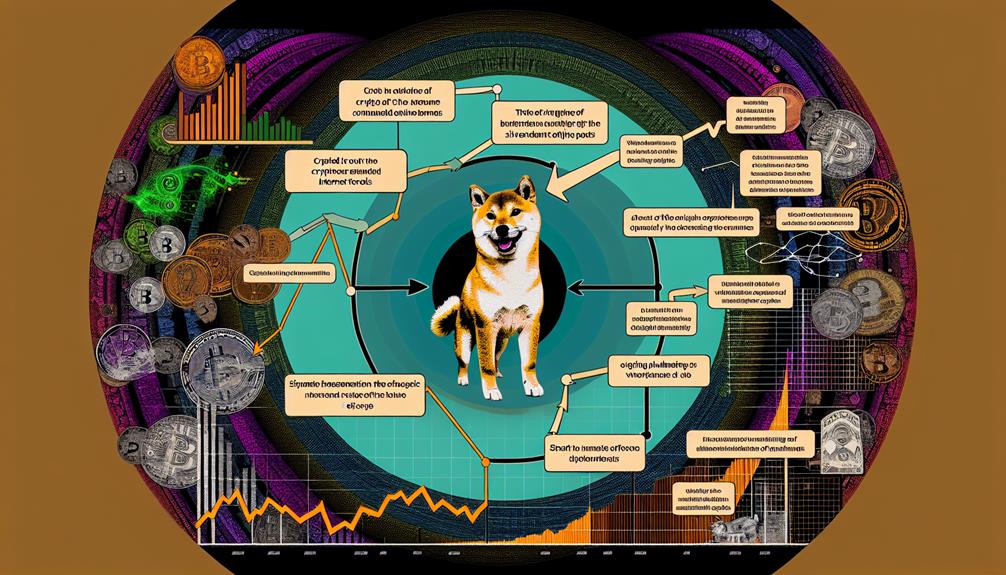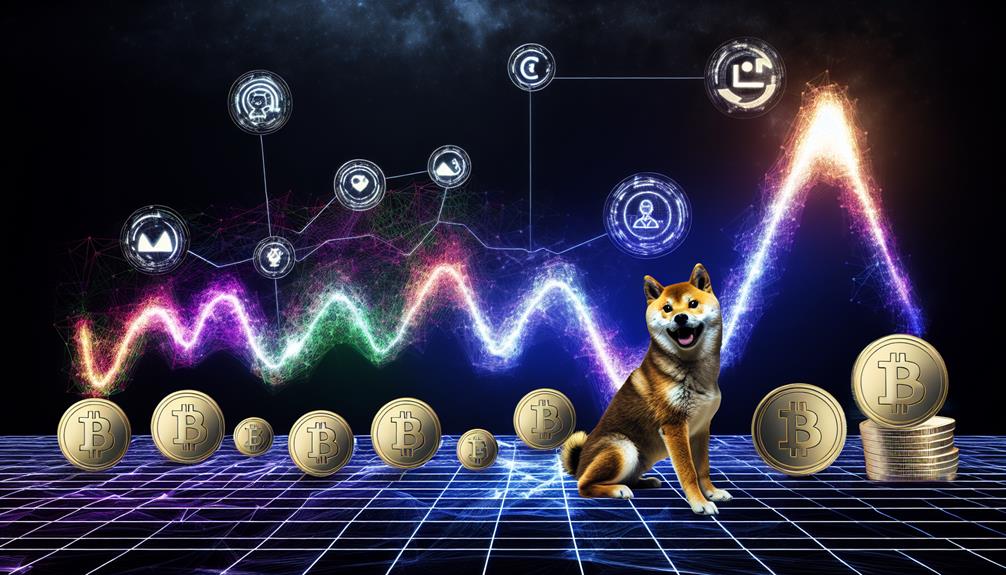Did you know that Dogecoin's trading volume surged by over 300% during its peak popularity in 2021? This statistic raises an important question: is Dogecoin still a viable player in the crypto market, or has it become irrelevant? While some analysts suggest it's losing steam, others argue that its community and cultural significance might keep it afloat. As you consider the factors influencing its value and potential future, you'll find that the answer may be more complex than it seems.
Overview of Dogecoin's History

Dogecoin, launched in December 2013, began as a lighthearted parody of Bitcoin, featuring the Shiba Inu dog from the popular "Doge" meme as its logo. You might find it interesting that this cryptocurrency quickly gained traction within meme culture, appealing to a diverse audience that appreciated its humor and accessibility. Unlike many digital currencies that focused on serious investment strategies, Dogecoin's creation was rooted in a grassroots movement aimed at fostering community engagement and cryptocurrency awareness.
Initially, Dogecoin was used primarily for tipping content creators and supporting charitable causes, which contributed to its rapid adoption. By leveraging the viral nature of memes, Dogecoin became a symbol of fun and inclusivity in the cryptocurrency landscape. The active online communities, particularly on platforms like Reddit and Twitter, played a significant role in promoting its use and expanding its reach.
As the years went by, Dogecoin's value experienced fluctuations, driven by social media trends and celebrity endorsements. Its transaction speed and low fees further solidified its standing as a practical alternative for microtransactions. However, it's important to emphasize that while Dogecoin started as a meme-inspired joke, its evolution reflects a complex interplay between digital culture and financial speculation. As you consider its history, think about how Dogecoin's grassroots beginnings highlight the potential for cryptocurrencies to transcend traditional financial boundaries and become a part of popular culture.
Current Market Trends
The current landscape of cryptocurrency trading has seen Dogecoin maneuvering a series of fluctuating market trends that reflect broader economic conditions and investor sentiment. Over the past year, Dogecoin's price has exhibited volatility, often correlating with major events in the cryptocurrency sphere and macroeconomic indicators. Despite initial excitement around its inception as a meme-based currency, its performance has become increasingly tied to market dynamics.
You might've noticed that spikes in Dogecoin's value often coincide with celebrity endorsements and social media campaigns. Figures like Elon Musk have played significant roles in driving interest and price surges through tweets and public statements. These endorsements have a twofold effect: they create a sense of community among investors and attract new participants drawn by the allure of potential gains. However, this reliance on external influencers can also lead to abrupt declines in value when the hype fades or if negative sentiment takes hold.
Additionally, the proliferation of Dogecoin memes has kept the currency in public discourse, fostering a culture around it that both entertains and informs. While these memes can boost engagement, they also risk trivializing the currency as a serious investment option.
As you analyze current market trends, it's essential to take into account how these factors interact with Dogecoin's performance. Understanding the balance between community-driven enthusiasm and market fundamentals will help you navigate the complexities of investing in Dogecoin.
Factors Influencing Dogecoin's Value

When considering Dogecoin's value, you need to look at several key factors, including market sentiment trends and recent technology developments. Additionally, competition from alternative cryptocurrencies can notably impact its standing in the market. Analyzing these elements can provide insight into Dogecoin's potential future trajectory.
Market Sentiment Trends
Frequently, market sentiment plays an essential role in determining Dogecoin's value, influenced by various external factors such as social media trends, celebrity endorsements, and broader cryptocurrency market movements. Understanding market psychology is vital for analyzing Dogecoin's price fluctuations. Sentiment analysis reveals how investor behavior shapes emotional trading, often leading to hype cycles that inflate prices temporarily.
The following table highlights key factors affecting market sentiment around Dogecoin:
| Factor | Influence on Dogecoin |
|---|---|
| Social Media Influence | Drives hype and speculation |
| Celebrity Endorsements | Boosts visibility and trust |
| Market Volatility | Heightens fear index and speculation |
| Speculative Trends | Encourages impulsive buying |
| Emotional Trading | Amplifies price swings |
As you can see, different aspects of behavioral finance contribute to the overall sentiment. When the market is optimistic, Dogecoin can experience rapid growth; conversely, fear can lead to sharp declines. This volatility illustrates how intertwined Dogecoin's value is with market sentiment, emphasizing the importance of monitoring these trends for future investment decisions.
Technology Developments Impact
Recent advancements in blockchain technology greatly influence Dogecoin's value, shaping its usability and adoption. The ongoing Dogecoin upgrades are vital for improving transaction speeds and network stability, which are key factors for users and investors alike. As technological innovations emerge, they often provide scalability solutions that can handle increased transaction volumes without compromising performance.
Developer contributions play an important role in these enhancements. A dedicated team is consistently working on security improvements to safeguard against vulnerabilities. Enhanced security measures not only protect users but also boost confidence in the coin's long-term viability. Additionally, blockchain enhancements can lead to decreased transaction fees, making Dogecoin a more attractive option for everyday transactions.
The combination of these factors—upgrades, innovations, and developer efforts—creates a robust ecosystem that can adapt to the evolving cryptocurrency landscape. As the market demands faster and more secure transactions, Dogecoin's ability to implement these technological developments will profoundly impact its value. If you're considering investing or using Dogecoin, keeping an eye on these advancements is essential, as they can directly influence your experience and potential returns in this dynamic market.
Competition From Alternatives
As the cryptocurrency market evolves, competition from alternative coins increasingly influences Dogecoin's value and market position. With numerous Dogecoin forks emerging, investors are often drawn to coins that promise improved transaction speed and scalability solutions. This trend can dilute Dogecoin's appeal, especially among tech-savvy investors seeking efficiency and lower fees.
Moreover, the dynamics of meme culture play a significant role in shaping investor demographics. While Dogecoin initially thrived on community-driven marketing strategies, newer alternatives are now leveraging influencer impact to capture attention and trading volumes. As a result, Dogecoin's brand loyalty may be tested, particularly when competing assets offer compelling narratives and unique features.
Market volatility also complicates Dogecoin's standing. As alternative cryptocurrencies fluctuate, investor sentiment shifts, often in favor of newer, more innovative projects. Scalability issues that Dogecoin faces further exacerbate these challenges, as investors become wary of its long-term viability.
Comparison With Other Cryptocurrencies
When comparing Dogecoin to other cryptocurrencies, it is crucial to analyze market performance trends, adoption rates, and community engagement levels. You'll find that while some cryptocurrencies have shown consistent growth and a robust user base, Dogecoin's metrics tell a different story. Understanding these differences can provide valuable context for evaluating Dogecoin's current standing in the crypto landscape.
Market Performance Trends
Dogecoin's market performance can be starkly contrasted with other cryptocurrencies, revealing significant trends that reflect its unique position in the digital currency landscape. Unlike established cryptocurrencies like Bitcoin and Ethereum, Dogecoin often experiences pronounced market volatility. This unpredictability can be attributed to its meme-based origins and the influence of social media trends.
When you compare Dogecoin's trading patterns to those of other cryptocurrencies, you'll notice that it often follows a different trajectory. While Bitcoin typically exhibits a more stable growth pattern, Dogecoin is prone to sharp spikes and drops, often reacting dramatically to market sentiment. This volatility can complicate your trading strategies, as timing becomes essential for maximizing returns.
Moreover, while many investors opt for long-term holding strategies with more stable currencies, the rapid shifts in Dogecoin's market value may encourage more active trading. Consequently, your approach to investing in Dogecoin might need to be more agile and responsive to external factors compared to more traditional cryptocurrencies. Ultimately, understanding these trends can provide you with a clearer perspective on Dogecoin's positioning within the broader cryptocurrency market.
Adoption Rates Comparison
In the landscape of cryptocurrency adoption, Dogecoin's trajectory presents a fascinating contrast to that of other digital currencies. While Bitcoin and Ethereum have established themselves as mainstream assets, Dogecoin faces unique adoption challenges. Its initial launch as a meme currency often overshadows its potential use cases, affecting its perception among investors and everyday users.
User demographics also play a significant role in this comparison. Bitcoin tends to attract a more traditional investor base, often comprising older, more affluent individuals, while Ethereum appeals to tech-savvy users interested in smart contracts and decentralized applications. In contrast, Dogecoin's user base skews younger and is often driven by community engagement and social media trends, which can be both a strength and a limitation.
Recent data illustrates that while Dogecoin has seen spikes in adoption during market rallies, its long-term growth remains inconsistent compared to its counterparts. This inconsistency could result from its branding and the inherent challenges of shifting from a novelty to a widely accepted payment method. Understanding these dynamics is vital for evaluating Dogecoin's future in the ever-evolving cryptocurrency landscape.
Community Engagement Levels
Amidst the evolving cryptocurrency landscape, community engagement levels considerably influence a coin's success and adoption. When you compare Dogecoin to other cryptocurrencies, it's vital to analyze both user engagement and community initiatives. Dogecoin has maintained a unique position with its passionate community, but how does it stack up against competitors like Bitcoin and Ethereum?
| Cryptocurrency | User Engagement (Monthly Active Users) | Community Initiatives |
|---|---|---|
| Dogecoin | 1.5 million | Charity events, memes |
| Bitcoin | 3 million | Developer funding |
| Ethereum | 2 million | Hackathons, grants |
From the table, you can see that while Bitcoin leads in user engagement numbers, Dogecoin's community initiatives, such as charity events and meme culture, foster a different kind of loyalty and engagement. This engagement translates into sustained interest and support, albeit in varying forms across the different cryptocurrencies. Understanding these dynamics is vital for evaluating Dogecoin's current standing and future potential in the market.
Community Support and Development

Many enthusiasts believe that the strength of a cryptocurrency lies in its community support and development efforts. Dogecoin's community has shown resilience, continually engaging in various community initiatives to promote the currency. These initiatives often revolve around charitable causes and social projects, showcasing the community's commitment to positive impact. For instance, Dogecoin has been involved in sponsoring events, funding charitable endeavors, and supporting grassroots movements, which reinforces its presence in the crypto space.
On the development side, Dogecoin has a relatively straightforward development roadmap, which sets clear objectives for future enhancements. The roadmap focuses on improving the network's scalability, security, and overall user experience. Developers are actively working on updates that aim to streamline transactions and reduce fees, which can attract more users. Recent improvements have included optimizations to the wallet interface and ongoing discussions about potential integrations with other platforms, reflecting a commitment to continuous improvement.
However, it is vital to analyze whether these community-driven efforts translate into sustained growth and adoption. While the community's enthusiasm is undeniable, the long-term viability of Dogecoin may hinge on how well these initiatives align with broader market trends and technological advancements. A strong community can provide support during downturns, but without significant development progress, the currency might struggle to maintain relevance. Consequently, monitoring both community engagement and development achievements will be significant in evaluating Dogecoin's future trajectory.
Future Predictions for Dogecoin
Historically, predictions about Dogecoin's future have often fluctuated based on market sentiment and social media influence. However, as you look ahead, several key factors could shape its trajectory. The expansion of Dogecoin usecases, including its adoption for transactions and tipping, could enhance its utility, making it more appealing to a broader audience.
Furthermore, Dogecoin partnerships with businesses and platforms can notably impact its value. As companies begin accepting Dogecoin for payments, its credibility may rise. Effective Dogecoin marketing campaigns, particularly those leveraging Dogecoin influencers, can further bolster public interest and investment. The proliferation of Dogecoin merchandise also indicates a growing community, which can facilitate its mainstream acceptance.
Scalability remains a vital issue. If the network can handle increased transaction volumes without delays, it'll be better positioned for growth. Additionally, the evolving landscape of Dogecoin regulation will play a pivotal role. Clearer regulations could either promote legitimacy or impose restrictions that might hinder its progress.
The cultural significance of Dogecoin memes continues to fuel its popularity, while community events and philanthropy initiatives foster a sense of belonging among users. These elements create a robust ecosystem that can sustain Dogecoin's relevance. Ultimately, while the future of Dogecoin carries uncertainties, its potential hinges on how effectively these factors are leveraged to foster growth and adaptation in an ever-changing crypto environment.
Frequently Asked Questions
What Is the Origin of the Dogecoin Meme?
The Dogecoin meme originated from a Shiba Inu image, symbolizing cryptocurrency humor. It embodies Internet culture's meme evolution, merging playful imagery with digital currency, appealing to both enthusiasts and casual users alike, driving its popularity.
How Can I Buy Dogecoin Safely?
Buying Dogecoin safely isn't rocket science, but it does require some thought. Guarantee your wallet security's excellent and explore various exchange options. Remember, a well-informed approach reduces risks and enhances your crypto experience.
What Are the Risks of Investing in Dogecoin?
Investing in Dogecoin involves volatility concerns and market speculation. Prices can fluctuate dramatically, driven by trends and social media buzz. You should assess your risk tolerance and stay informed to make educated investment decisions.
Is Dogecoin Accepted by Any Major Retailers?
You might be surprised to learn that Dogecoin adoption has grown, with some major retailers forming retail partnerships. While it's not universally accepted, companies like Tesla and Newegg have embraced Dogecoin for transactions, showcasing its evolving presence.
Can Dogecoin Be Mined, and How?
Yes, you can mine Dogecoin through its mining process, which involves solving complex mathematical problems. Miners receive block rewards in the form of Dogecoin for their efforts, contributing to the network's security and transaction verification.
Conclusion
In summary, Dogecoin isn't dead; it's merely evolving. Like the phoenix that rises from its ashes, its active community and potential use cases hint at a promising future. While market volatility remains a concern, the cultural significance and ongoing development efforts keep it alive in the cryptocurrency domain. As you navigate this landscape, remember that trends change, and what seems like a fleeting meme today could transform into something more substantial tomorrow.
